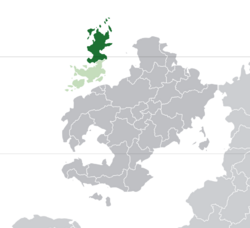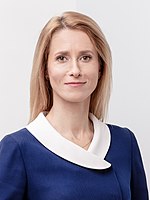Svaldland
Republic of Svaldland Tjodvelden Sväljdland (Svaldish) | |
|---|---|
|
Flag | |
| Motto: För mitt land, mitt liv For my country, my life | |
| Anthem: "Nordens Ljus" "Light of the North" | |
 Location of Svaldland (dark green) – in Messenia (green & dark grey) | |
| Capital | Lysandstad |
| Largest city | Valhamn |
| Official languages | Svaldish |
| Recognised regional languages | |
| Religion (2022) | |
| Demonym(s) | Svaldish |
| Government | Unitary parliamentary constitutional republic |
| Emil Lundell | |
• Premier | Sigrid Rika Ström |
| Legislature | Folketsting |
| Independence from the Kingdom of Hallania | |
• Svaldish settlement | c. 75 CE |
| c. 889 CE | |
• Union of the Crowns under Gustav I & III | 11 May 1655 |
| 4 September 1812 | |
| 16 June 1916 | |
• Republic established | 2 August 1916 |
• Founded the Hallanic Commonwealth | 20 June 1956 |
| Area | |
• Total | 206,770 km2 (79,830 sq mi) |
• Water (%) | 2.8 |
| Population | |
• 2022 census | 9,367,523 |
• Density | 45.3/km2 (117.3/sq mi) |
| GDP (PPP) | 2022 estimate |
• Total | $532.22 billion |
• Per capita | $56,815 |
| GDP (nominal) | 2022 estimate |
• Total | $453.19 billion |
• Per capita | $48,379 |
| ISO 3166 code | SVA |
| Internet TLD | .sv |
Svaldland (Svaldish: Sväljdland), officially the Republic of Svaldland (Svaldish: Tjodvelden Sväljdland), is a sovereign state in Hallania, which occupies the northern half of Storhalland in addition to hundreds of smaller islands including Västraön, the third-largest island in the Hallic archipelago. Svaldland shares a single border with Narrland-Crethia to the south, and is surrounded on all other sides by the Coldwind Sea. The country has a population of 9 million, the overwhelming majority of which lives south of the 60th parallel close to the Narrish border. This region is home to the capital city of Lysandstad and Valhamn, Svaldland's largest city.
The earliest confirmed human habitation of Svaldland is dated to after the Mesolithic, as repeated glaciations destroyed evidence of habitation before this period. The first confirmed habitation was around 12,000 years ago, after the ice sheet retreated. Old Hallians settled in Svaldland some time before the Tiberian conquest of Lilledel, around 75 CE, subjugating the indigenous paleo-Hallic peoples. In the Svaldish Disitruar oral tradition, the Svaldish settlers were led by the culture hero Sönnungr, who married the jötunn princess Dröfn, uniting the Svalds with the paleo-Hallic people. The Svaldish people at this time were organised into disparate tribal clan states, and while many petty kings identified as Rex Svaldorum, it was not until 889 that a single Svaldish state emerged under Knut Langertan. Svaldish monks and gothi attended the First Synod which codified the Disitru faith.
Svaldland was considered a backwater kingdom for most of the Middle Ages. Social organisation developed along the lines of munkaskattur, and monks became a major social class in the kingdom. The country was home to the Damen Reformation in the 12th century, which led to the emergence of the now-dominant Damentru tradition of Disitru. The country established colonies in Newfoundland starting in the 13th century, but eventually lost most of these colonies to other powers. In 1655, the Svaldish monarch Gustav III inherited the throne of the rival Kingdom of Narrland, united the two crowns and leading to the eventual unification of the two kingdoms and the Principality of Lilledel as the Kingdom of Hallania in 1812. As part of Hallania, Svaldland was one of the centres of the Industrial Revolution, and was an active participant in Hallanic colonialism, particularly after Hallania's victory in the War of the Aussonian Succession. Nevertheless, at the same time there was a general revival of Svaldish culture and a growing repudiation of Narrish hegemony.
In the aftermath of the Hallanic defeat in the First Continental War, Svaldland declared independence from Hallania and took part in the Hallanic Wars. There was conflict within and without the country between the communist reds, the republican greens and the loyalist whites. The greens were successful, and Svaldland emerged as a republic. The Loose Ends War in 1919 was the final conflict which Svaldland took part in. It remained neutral during the Second Continental War, and hosted the Treaty of Lysandstad which ended the conflict. Svaldland helped to create the Hallanic Commonwealth in 1956 and HALSAT in 1967, fostering cooperation between the post-Hallanic states. The Svaldish economy remained focused on manufacturing until the 1990s, when deregulation and trade law reform led to an economic boom.
Svaldland is a unitary parliamentary republic, and is seen as a liberal democracy. The current President is Emil Lundell, while the current Premier is Sigrid Rika Ström of the National Liberals. The country ranks highly on indices for democracy and stability. The Svaldish economy is developed, diversified and high-income, with a nominal GDP per capita of $48,379. The shipbuilding industry has shrunk in recent years, but the Port of Valhamn remains the largest in Hallania and Lysandstad has emerged as a financial hub. Svaldland is a founding member of the Hallanic Commonwealth, the North Messenian Trade Organisation and the Concert of Nations.
Etymology
The Wellish exonym Svaldland is directly derived from the Svaldish endonym Sväljdland. This name is derived from the Old Svaldish word svælgha, meaning "to devour", as early Svaldish mythology believed that the Svaldish tribes were scions of jörmungandr, and so referred to themselves as Værldsvælgher, or "world devourers". The world affix was eventually dropped, leading to Svælghaland, and the hard gh sound shifted into the modern jd, leading to the modern name. The country was also previously known by the name Svaldheim or Sväljdheim, but this name is now considered archaic.
History
Government and politics
Demographics
Language
Religion
Svaldland is seen as a historically Disitruar nation, and forms of Disitru have dominated religious life in Svaldland since Svaldish monks and gothi attended the First Synod in the 9th century. Disitru was the state religion of the Kingdom of Svaldland and of the succeeding Kingdom of Hallania, with the Grand Synod forming the state church of Hallania. Disitru was import to the historical development of Svaldland, leading to the social organisation known as munkaskattur, and Svaldland was central to the Disitru faith, being home to the Damen Reformation in the 12th century, which led to the emergence of the now-dominant Damentru tradition of Disitru. It wasn't until the declaration of a Svaldish republic in 1916 that secularism and religious freedom was embraced as official government policy, enshrined in the constitution, with the Hallanic Grand and Svaldish High Synod being disestablished.
Disitru remains the largest nominal religion in Svaldland even in the secular environment. In the 2022 census 54.8% of respondents identified as Disitruar. The largest denomination of Disitru remains Damentru, with 42.7% of Svalds identifying with that denomination. The second largest is the older Tyrinntru tradition, whiich 8.9% of the population adheres to. Smaller Disitru denominations comprise a further 5.6% of the Svaldish population, with the largest among these being Frelsuntru with 1.7% and Vitentru with 0.6% of the population. As part of the Svaldish Disitru tradition, the semi-mythical king and culture hero Sönnungr is prominent, and he is considered the patron deity of Svaldland.
Although not a creed, irreligion ranks second in terms of numbers of respondents to the 2022 census, with 33.6% of the population declaring that they have no religion. This is a mostly modern phenonemon, but draws on the history of Svaldland through groups such as the goðlauss, who nominally adhered to the cultural aspects of Disitru, but rejected most spiritual elements of the faith. A further 4.2% of the population did not state their religion on the census.
The second largest religion in Svaldland is Ditanery, which has had a presence in wider Hallania since its establishment. There are nearly 300,000 Ditanists in Svaldland, with adherents comprising 3.2% of the population. The largest Ditanist sect in Svaldland is the Hallanic-origin Seithor discipline, which accounts for the vast majority of Ditanists in Svaldland. Ditanists have historically been subject to discrimination within Svaldland, which has contributed to the historical animosity between Disitru and Ditanery. The third largest faith is Saturnism, which accounts for 1.7% of the population and similarly to Ditanery has had a long presence in Svaldland. Rodnevary has a far smaller presence in Svaldland, at 0.3% of the population, but has a similarly integrated history with the country similar to Ditanery and Saturnism.
The fourth and fifth largest religions are Ihtiram and Samsara, which comprise 0.8% and 0.5% of the population respectively. Together with other religions such as Gyhad at 0.2%, these religions have a more recent history in Svaldland, being largely tied to immigration from the former Hallanic Empire and modern immigration from across the world. These religions are therefore concentrated among minority ethnic groups and in migrant communities.


